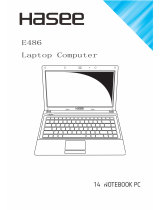
Connecting external audio devices .................................................................................... 43
Checking your audio functions ........................................................................................... 43
Video .................................................................................................................................................. 44
Connecting an external monitor or projector ...................................................................... 44
Using the external monitor port ......................................................................... 44
Using the DisplayPort ........................................................................................ 45
Optical drives (select models only) ..................................................................................................... 46
Identifying the installed optical drive .................................................................................. 46
Playing a CD or DVD ......................................................................................................... 46
Changing DVD region settings .......................................................................................... 47
Creating (burning) a CD or DVD ........................................................................................ 47
Removing an optical disc (CD or DVD) ............................................................................. 48
Webcam ............................................................................................................................................. 49
Adjusting webcam properties ............................................................................................. 49
Controlling the webcam focus ............................................................................................ 50
Capturing business card images ....................................................................................... 50
5 Power management
Setting power options ......................................................................................................................... 52
Using power-saving states ................................................................................................. 52
Initiating and exiting Standby ............................................................................ 52
Initiating and exiting Hibernation ....................................................................... 53
Using the Power Meter ...................................................................................................... 53
Using power schemes ....................................................................................................... 54
Viewing the current scheme .............................................................................. 54
Selecting a different power scheme .................................................................. 54
Customizing power schemes ............................................................................ 55
Setting password protection upon exiting Standby ............................................................ 55
Using external AC power .................................................................................................................... 55
Connecting the AC adapter ............................................................................................... 56
Using battery power ........................................................................................................................... 56
Displaying the remaining battery charge ........................................................................... 57
Inserting or removing the battery ....................................................................................... 57
Charging a battery ............................................................................................................. 58
Maximizing battery discharge time .................................................................................... 59
Managing low battery levels .............................................................................................. 59
Identifying low battery levels ............................................................................. 60
Resolving a low battery level ............................................................................. 61
Resolving a low battery level when external power is available ....... 61
Resolving a low battery level when a charged battery is
available ........................................................................................... 61
Resolving a low battery level when no power source is
available ........................................................................................... 61
vii




















